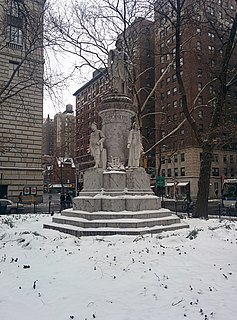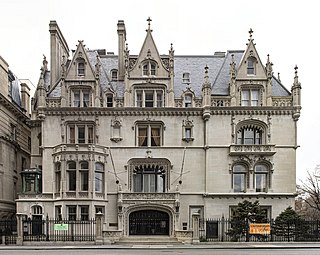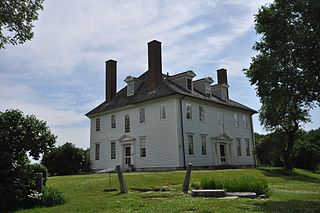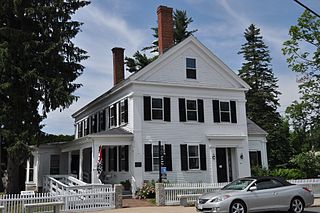
Griswold is a town in New London County, Connecticut, United States. The population was 11,402 at the 2020 census. Griswold contains one borough, Jewett City, and also contains the villages of Doaneville, Kaalmanville, Rixtown, Glasgo, Hopeville, Nathanieltown, and Pachaug.
Westerleigh is a residential neighborhood in the northwestern part of Staten Island in New York City.

Wave Hill is a 28-acre (11 ha) estate in the Hudson Hill section of Riverdale in the Bronx, New York City. Wave Hill currently consists of public horticultural gardens and a cultural center, all situated on the slopes overlooking the Hudson River, with expansive views across the river to the New Jersey Palisades. The estate includes two houses and a botanical garden. The oldest part of the main house, Wave Hill House, dates back to 1843; Glyndor House dates from 1927 and contains a multi-room art gallery. Perkins Visitor Center, which was originally a garage, contains a gift shop and an information desk.

This is intended to be a complete list of properties and districts listed on the National Register of Historic Places in Orleans County, New York. The locations of National Register properties and districts may be seen in a map by clicking on "Map of all coordinates". Two listings, the New York State Barge Canal and the Cobblestone Historic District, are further designated a National Historic Landmark.

Verdi Square is a small triangle on Upper West Side of Manhattan, New York City. It is between 72nd Street on the south, 73rd Street on the north, Broadway on the west, and Amsterdam Avenue on the east. On the south the square fronts West 72nd Street; across the street to the south lies Sherman Square. On the north side, the park faces the Apple Bank for Savings' central building at 2112 Broadway, designed by York and Sawyer.

The Sarah Orne Jewett House is a historic house museum at 5 Portland Street in South Berwick, Maine, United States. The house was designated a National Historic Landmark in 1991 for its lifelong association with the American author Sarah Orne Jewett (1849–1909), whose influential work exemplified regional writing of the late 19th century. The house, built in 1774, is a high-quality example of late Georgian architecture. It is now owned by Historic New England, and is open for tours every weekend between June and October, and two Saturdays per month the rest of the year.

The Harry F. Sinclair House is a mansion at the southeast corner of East 79th Street and Fifth Avenue on the Upper East Side of Manhattan in New York City. The house was built between 1897 and 1899. Over the first half of the 20th century, the house was successively the residence of businessmen Isaac D. Fletcher and Harry F. Sinclair, and then the descendants of Peter Stuyvesant, the last Director of New Netherland. The Ukrainian Institute of America acquired the home in 1955. After the house gradually fell into disrepair, the institute renovated the building in the 1990s. The house was added to the National Register of Historic Places (NRHP) and was named a National Historic Landmark in 1978.

The Jonathan Hamilton House, also known as the Hamilton House, is a historic house at 40 Vaughan's Lane in South Berwick, Maine. Built between 1787 and 1788 by a merchant from Portsmouth, New Hampshire, this National Historic Landmark is a little-altered and high quality late Georgian country house. Acquired by preservationist friends of South Berwick native Sarah Orne Jewett at the turn of the 20th century, it is now a historic house museum owned by Historic New England, open for tours between June and October.

The John Wilson House is a historic house at 29–31 Ashland Street in the borough of Jewett City in the town of Griswold, Connecticut. Built about 1781, it is significant locally as a fine example of Georgian residential architecture, and as the home of John Wilson, a leading local industrialist of the late 18th century. The house was listed on the National Register of Historic Places in 1985.

Clarkson Corners Historic District is a national historic district located at the hamlet of Clarkson Corners in Monroe County, New York. The district encompasses approximately 60 historic resources associated with the Clarkson crossroads development between about 1804 and 1910.

The Lebbeus Ford House is a historic house located on Jewett Hill Road in Berkshire, Tioga County, New York.

The Skaneateles Historic District is a 17 acres (6.9 ha) historic district in the village of Skaneateles, New York that dates back to 1796, includes one building from the 20th century, but is otherwise composed of 19th-century residences and commercial buildings. It includes 59 contributing buildings and one contributing site – Thayer Park along Skaneateles Lake, – as well as five non-contributing structures. The district runs along both sides of East Genesee Street from Jordan Street to Onondaga Street, and includes the core of Skaneateles' historic downtown area, which was rebuilt in 1836 after being almost totally destroyed by fire in 1835. Also included are properties on Jordan Street up to the intersection of Fennell Street, and the stone mill property on Fennell Street.

Jewett Presbyterian Church Complex is a historic Presbyterian church on Church Street in Jewett, Greene County, New York. The complex consists of the 1848 Jewett Presbyterian Church and adjacent 1848 former Methodist Episcopal Church. The Jewett Presbyterian Church is a two-story, four by three bay timber-framed building sheathed in clapboard and topped by a gable roof. The former Methodist Episcopal Church was built using a one-story, four by three bay plan and features a moderately pitched gable roof. Both structures feature Greek Revival design elements.

Clapham-Stern House, also known as Wenlo and originally known as Stone House, is a historic mansion located at Roslyn Harbor in Nassau County, New York. It was originally built between 1868 and 1872 and turned into a premier estate in 1906 after being purchased by department store magnate Benjamin Stern. It is an asymmetrical 2+1⁄2-story dwelling resting on a full basement. It consists of a main block with wings to the north and south, a tower, and a piazza wrapping around the south and west sides. It is constructed of rough-faced gray Greenwich granite accented by limestone. It has a moderately pitched hipped slate roof with copper cresting. After a major fire in 1960, the house was returned to a High Victorian Gothic style. Also on the property is a contributing bathhouse dated to the 1920s.

The West Hill Covered Bridge, also known as the Crystal Springs Covered Bridge is a wooden covered bridge that crosses West Hill Brook on Creamery Bridge Road in Montgomery, Vermont. It is one of six surviving 19th-century bridges built in Montgomery by the brothers Sheldon & Savannah Jewett. It was listed on the National Register of Historic Places in 1974.

The Jewett-Kemp-Marlens House is a historic house on North Road in Alstead, New Hampshire. Probably built sometime between 1798 and 1806, the house is notable for the well-preserved and conserved stencilwork of the itinerant 19th-century folk artist Moses Eaton. The house was listed on the National Register of Historic Places in 1997.

The Jewett-Eastman House is a historic house at 37 Portland Street in the center of South Berwick, Maine. Built about 1850, it is a fine local example of Greek Revival architecture. It is most notable for its association with the Jewett family, which included a prominent local businessman and a doctor, as well as the writer Sarah Orne Jewett, who was raised in this house. It served the town for a time as its public library, and is now owned by Historic New England, serving as a gallery space and as the visitors center for the adjacent Sarah Orne Jewett House.

The George B. Peak House, also known as New Life Eternity House, is a historic building located in Des Moines, Iowa, United States. It is a 2½-story brick dwelling that features a hipped roof with a flat deck, pedimented dormers, and a portico with freestanding columns. It was built for George M. Peak who came to Des Moines in 1888 from Kentucky. He worked as the local manager of the Equitable Life Assurance Society of the U.S. before he organized the Central Life Assurance Society of the U.S. in 1896. He served as president of the later until his death. He also promoted the Insurance Exchange building in Des Moines, and advocated for the construction of Keosauqua Way. After Peak died in 1923 the house was acquired for use as a fraternity and then a sorority house for Drake University. It has since been converted into a multi-family dwelling. The house was listed on the National Register of Historic Places in 1978.





















